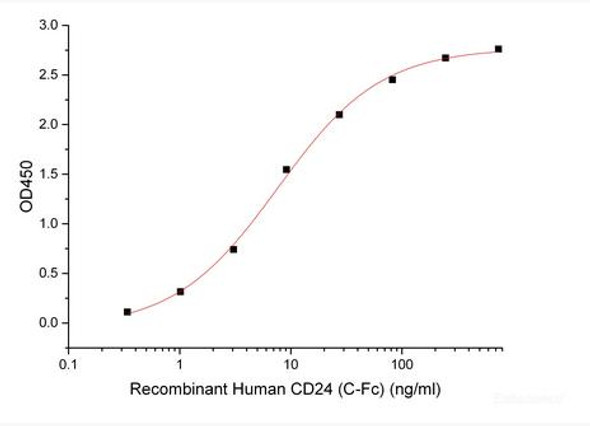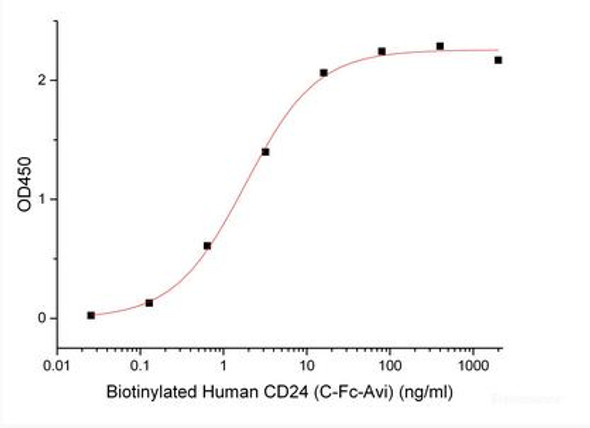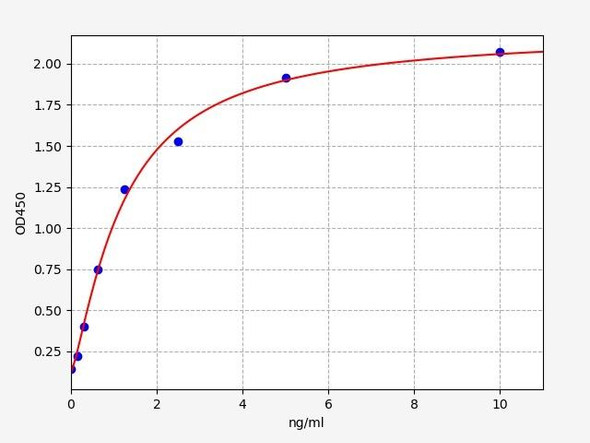Description
Human Signal transducer CD24 (CD24) ELISA Kit
The Human CD24 ELISA Kit from AssayGenie is specifically designed for the precise measurement of CD24 levels in human samples such as serum, plasma, and cell culture supernatants. With its high sensitivity and specificity, this kit ensures accurate and reproducible results, making it an excellent tool for various research applications.CD24, also known as signal transducer CD24, is a cell surface protein that plays a crucial role in cell signaling and immune responses. It is involved in various physiological processes such as cell adhesion, migration, and differentiation.
Dysregulation of CD24 expression has been linked to cancer, inflammatory diseases, and autoimmune disorders, making it a valuable biomarker for studying these conditions and developing potential therapeutic interventions.Overall, the Human CD24 ELISA Kit offers researchers a reliable and efficient method for quantifying CD24 levels in human samples, providing valuable insights into its biological function and potential clinical relevance.
| Product Name: | Human Signal transducer CD24 (CD24) ELISA Kit |
| SKU: | HUEB2243 |
| Size: | 96T |
| Target: | Human Signal transducer CD24 (CD24) |
| Synonyms: | Small cell lung carcinoma cluster 4 antigen, CD24, CD24A |
| Assay Type: | Sandwich |
| Detection Method: | ELISA |
| Reactivity: | Human |
| Detection Range: | 0.156-10ng/mL |
| Sensitivity: | 0.078ng/mL |
| Intra CV: | 4.9% | ||||||||||||||||||||
| Inter CV: | 7.8% | ||||||||||||||||||||
| Linearity: |
| ||||||||||||||||||||
| Recovery: |
| ||||||||||||||||||||
| Function: | Modulates B-cell activation responses. Signaling could be triggered by the binding of a lectin-like ligand to the CD24 carbohydrates, and transduced by the release of second messengers derived from the GPI-anchor. Promotes AG-dependent proliferation of B-cells, and prevents their terminal differentiation into antibody-forming cells. |
| Uniprot: | P25063 |
| Sample Type: | Serum, plasma, tissue homogenates, cell culture supernates and other biological fluids |
| Specificity: | Natural and recombinant human Signal transducer CD24 |
| Sub Unit: | Interacts with LYN and FGR in a cell-type specific manner. Binds FRG in a small cell cancer line, LYN in the erythroleukemia cell line K-562 and in Burkitt's lymphoma. |
| Subcellular Location: | Cell membrane Lipid-anchor GPI-anchor |
| Storage: | Please see kit components below for exact storage details |
| Note: | For research use only |
| UniProt Protein Function: | CD24: Modulates B-cell activation responses. Signaling could be triggered by the binding of a lectin-like ligand to the CD24 carbohydrates, and transduced by the release of second messengers derived from the GPI-anchor. Promotes AG-dependent proliferation of B-cells, and prevents their terminal differentiation into antibody-forming cells. Genetic variations in CD24 are associated with susceptibility to multiple sclerosis (MS). A multifactorial, inflammatory, demyelinating disease of the central nervous system. Sclerotic lesions are characterized by perivascular infiltration of monocytes and lymphocytes and appear as indurated areas in pathologic specimens (sclerosis in plaques). The pathological mechanism is regarded as an autoimmune attack of the myelin sheat, mediated by both cellular and humoral immunity. Clinical manifestations include visual loss, extra-ocular movement disorders, paresthesias, loss of sensation, weakness, dysarthria, spasticity, ataxia and bladder dysfunction. Genetic and environmental factors influence susceptibility to the disease. Polymorphisms in CD24 may act as a genetic modifier for susceptibility and progression of MS in some populations, perhaps by affecting the efficiency of CD24 expression on the cell surface. Belongs to the CD24 family. |
| UniProt Protein Details: | Protein type:Membrane protein, GPI anchor; Cell surface; Cell development/differentiation; Motility/polarity/chemotaxis Chromosomal Location of Human Ortholog: 6q21 Cellular Component: cell surface; membrane; plasma membrane; lipid raft Molecular Function:protein binding; signal transducer activity; protein tyrosine kinase activator activity; protein kinase binding Biological Process: respiratory burst; axon guidance; cell migration; Wnt receptor signaling pathway; regulation of phosphorylation; B cell receptor transport into lipid raft; immune response-regulating cell surface receptor signaling pathway; chemokine receptor transport out of lipid raft; positive regulation of activated T cell proliferation; positive regulation of MAP kinase activity; cell activation; cholesterol homeostasis; cell-cell adhesion; elevation of cytosolic calcium ion concentration; response to estrogen stimulus; response to molecule of bacterial origin; regulation of MAPKKK cascade; negative regulation of transforming growth factor-beta3 production; T cell costimulation; regulation of epithelial cell differentiation; response to hypoxia; regulation of cytokine and chemokine mediated signaling pathway Disease: Multiple Sclerosis, Susceptibility To |
| UniProt Code: | P25063 |
| NCBI GenInfo Identifier: | 143811372 |
| NCBI Gene ID: | |
| NCBI Accession: | P25063.2 |
| Molecular Weight: | |
| NCBI Full Name: | Signal transducer CD24 |
| UniProt Protein Name: | Signal transducer CD24 |
| UniProt Synonym Protein Names: | Small cell lung carcinoma cluster 4 antigen; CD_antigen: CD24 |
| Protein Family: | Signal transducer |
| UniProt Gene Name: | CD24 |
| UniProt Entry Name: | CD24_HUMAN |
| Component | Quantity (96 Assays) | Storage |
| ELISA Microplate (Dismountable) | 8×12 strips | -20°C |
| Lyophilized Standard | 2 | -20°C |
| Sample Diluent | 20ml | -20°C |
| Assay Diluent A | 10mL | -20°C |
| Assay Diluent B | 10mL | -20°C |
| Detection Reagent A | 120µL | -20°C |
| Detection Reagent B | 120µL | -20°C |
| Wash Buffer | 30mL | 4°C |
| Substrate | 10mL | 4°C |
| Stop Solution | 10mL | 4°C |
| Plate Sealer | 5 | - |
Other materials and equipment required:
- Microplate reader with 450 nm wavelength filter
- Multichannel Pipette, Pipette, microcentrifuge tubes and disposable pipette tips
- Incubator
- Deionized or distilled water
- Absorbent paper
- Buffer resevoir
*Note: The below protocol is a sample protocol. Protocols are specific to each batch/lot. For the correct instructions please follow the protocol included in your kit.
Allow all reagents to reach room temperature (Please do not dissolve the reagents at 37°C directly). All the reagents should be mixed thoroughly by gently swirling before pipetting. Avoid foaming. Keep appropriate numbers of strips for 1 experiment and remove extra strips from microtiter plate. Removed strips should be resealed and stored at -20°C until the kits expiry date. Prepare all reagents, working standards and samples as directed in the previous sections. Please predict the concentration before assaying. If values for these are not within the range of the standard curve, users must determine the optimal sample dilutions for their experiments. We recommend running all samples in duplicate.
| Step | |
| 1. | Add Sample: Add 100µL of Standard, Blank, or Sample per well. The blank well is added with Sample diluent. Solutions are added to the bottom of micro ELISA plate well, avoid inside wall touching and foaming as possible. Mix it gently. Cover the plate with sealer we provided. Incubate for 120 minutes at 37°C. |
| 2. | Remove the liquid from each well, don't wash. Add 100µL of Detection Reagent A working solution to each well. Cover with the Plate sealer. Gently tap the plate to ensure thorough mixing. Incubate for 1 hour at 37°C. Note: if Detection Reagent A appears cloudy warm to room temperature until solution is uniform. |
| 3. | Aspirate each well and wash, repeating the process three times. Wash by filling each well with Wash Buffer (approximately 400µL) (a squirt bottle, multi-channel pipette,manifold dispenser or automated washer are needed). Complete removal of liquid at each step is essential. After the last wash, completely remove remaining Wash Buffer by aspirating or decanting. Invert the plate and pat it against thick clean absorbent paper. |
| 4. | Add 100µL of Detection Reagent B working solution to each well. Cover with the Plate sealer. Incubate for 60 minutes at 37°C. |
| 5. | Repeat the wash process for five times as conducted in step 3. |
| 6. | Add 90µL of Substrate Solution to each well. Cover with a new Plate sealer and incubate for 10-20 minutes at 37°C. Protect the plate from light. The reaction time can be shortened or extended according to the actual color change, but this should not exceed more than 30 minutes. When apparent gradient appears in standard wells, user should terminatethe reaction. |
| 7. | Add 50µL of Stop Solution to each well. If color change does not appear uniform, gently tap the plate to ensure thorough mixing. |
| 8. | Determine the optical density (OD value) of each well at once, using a micro-plate reader set to 450 nm. User should open the micro-plate reader in advance, preheat the instrument, and set the testing parameters. |
| 9. | After experiment, store all reagents according to the specified storage temperature respectively until their expiry. |
When carrying out an ELISA assay it is important to prepare your samples in order to achieve the best possible results. Below we have a list of procedures for the preparation of samples for different sample types.
| Sample Type | Protocol |
| Serum | If using serum separator tubes, allow samples to clot for 30 minutes at room temperature. Centrifuge for 10 minutes at 1,000x g. Collect the serum fraction and assay promptly or aliquot and store the samples at -80°C. Avoid multiple freeze-thaw cycles. If serum separator tubes are not being used, allow samples to clot overnight at 2-8°C. Centrifuge for 10 minutes at 1,000x g. Remove serum and assay promptly or aliquot and store the samples at -80°C. Avoid multiple freeze-thaw cycles. |
| Plasma | Collect plasma using EDTA or heparin as an anticoagulant. Centrifuge samples at 4°C for 15 mins at 1000 × g within 30 mins of collection. Collect the plasma fraction and assay promptly or aliquot and store the samples at -80°C. Avoid multiple freeze-thaw cycles. Note: Over haemolysed samples are not suitable for use with this kit. |
| Urine & Cerebrospinal Fluid | Collect the urine (mid-stream) in a sterile container, centrifuge for 20 mins at 2000-3000 rpm. Remove supernatant and assay immediately. If any precipitation is detected, repeat the centrifugation step. A similar protocol can be used for cerebrospinal fluid. |
| Cell culture supernatant | Collect the cell culture media by pipette, followed by centrifugation at 4°C for 20 mins at 1500 rpm. Collect the clear supernatant and assay immediately. |
| Cell lysates | Solubilize cells in lysis buffer and allow to sit on ice for 30 minutes. Centrifuge tubes at 14,000 x g for 5 minutes to remove insoluble material. Aliquot the supernatant into a new tube and discard the remaining whole cell extract. Quantify total protein concentration using a total protein assay. Assay immediately or aliquot and store at ≤ -20 °C. |
| Tissue homogenates | The preparation of tissue homogenates will vary depending upon tissue type. Rinse tissue with 1X PBS to remove excess blood & homogenize in 20ml of 1X PBS (including protease inhibitors) and store overnight at ≤ -20°C. Two freeze-thaw cycles are required to break the cell membranes. To further disrupt the cell membranes you can sonicate the samples. Centrifuge homogenates for 5 mins at 5000xg. Remove the supernatant and assay immediately or aliquot and store at -20°C or -80°C. |
| Tissue lysates | Rinse tissue with PBS, cut into 1-2 mm pieces, and homogenize with a tissue homogenizer in PBS. Add an equal volume of RIPA buffer containing protease inhibitors and lyse tissues at room temperature for 30 minutes with gentle agitation. Centrifuge to remove debris. Quantify total protein concentration using a total protein assay. Assay immediately or aliquot and store at ≤ -20 °C. |
| Breast Milk | Collect milk samples and centrifuge at 10,000 x g for 60 min at 4°C. Aliquot the supernatant and assay. For long term use, store samples at -80°C. Minimize freeze/thaw cycles. |
| ELISA |
| Human CD24 ELISA Kit |










